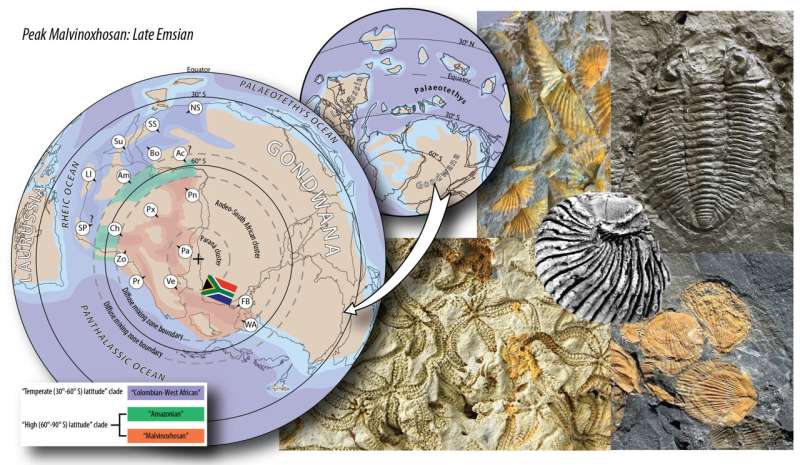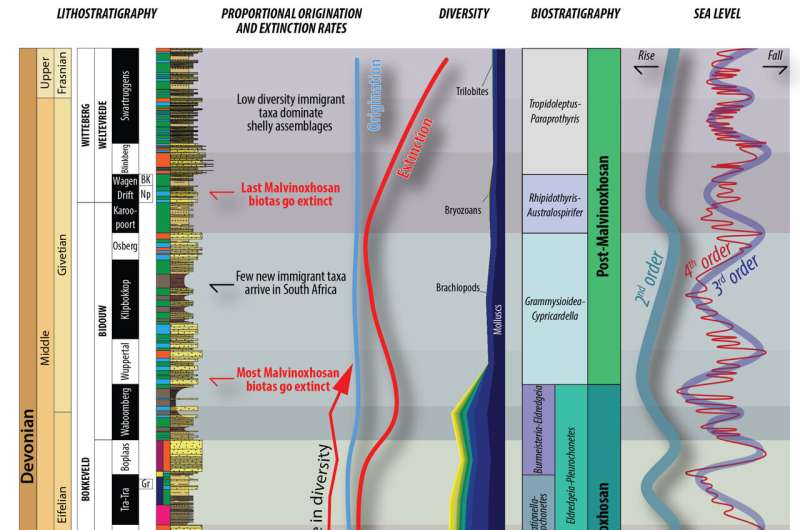This article has been reviewed according to Science X's editorial process and policies. Editors have highlighted the following attributes while ensuring the content's credibility:
fact-checked
peer-reviewed publication
trusted source
proofread
Waves of change: How sea-levels and climate altered the marine ecosystems at the South Pole 390–385 million years ago

During the Early-Middle Devonian period, a large landmass called Gondwana—which included parts of today's Africa, South America, and Antarctica—was located near the South Pole. Unlike today's icy conditions, the climate was warmer, and the sea levels were higher, flooding most of the land.
The Malvinoxhosan biota were a group of marine animals that thrived in cooler waters. They included various types of shellfish, many of which are now extinct.
"The origin and disappearance of these animals have remained an enigma for nearly two centuries until now," says Dr. Cameron Penn-Clarke, first author of a new study titled "The rise and fall of the Malvinoxhosan (Malvinokaffric) bioregion in South Africa: Evidence for Early-Middle Devonian biocrises at the South Pole," published in Earth-Science Reviews.
The researchers collected and analyzed a vast amount of fossil data. They used advanced data analysis techniques to sort through layers of ancient rock based on the types of fossils found in them. Imagine it like sorting through layers of a cake, each with different ingredients. They then identified at least 7 to 8 distinct layers, each showing fewer and fewer types of marine animals over time. These findings were then compared with how the environment and sea levels have changed, as well as with global temperature records from that ancient period.
They found that these marine animals went through several phases of declining numbers of different species, which correlated with changes in sea levels and climate. It was a difficult process.
"This research is around 12-15 years in the making, and it wasn't an easy journey," shares Dr. Penn-Clarke. "I was only able to overcome all the different challenges through dogged persistence and perseverance."

Their research suggests that the Malvinoxhosan biota survived during a long period of global cooling. Dr. Penn-Clarke elaborates, "We think that cooler conditions allowed for the creation of circumpolar thermal barriers—essentially, ocean currents near the poles—that isolated these animals and led to their specialization."
As the climate warmed up again, these animals disappeared. They were replaced by more generalist marine species that are well-adapted to warmer waters. Shifts in sea levels during the Early-Middle Devonian period probably disrupted natural ocean barriers that had kept waters cooler at the South Pole. This allowed warmer waters from regions closer to the equator to flow in, setting the stage for marine animals that thrive in warmer conditions to move into these areas.
As a result, these warm-water species gradually took over, leading to the decline and eventual disappearance of the specialized, cool-water Malvinoxhosan marine animals.
The extinction of the Malvinoxhosan biota led to a complete collapse in polar ecosystems, as biodiversity in these regions never recovered.
"This suggests a complete collapse in the functioning of polar environments and ecosystems to the point that they could never recover," Dr. Penn-Clarke adds. He likens this research to playing a game of Cluedo.
It's a 390-million-year-old murder mystery. We now know that the combined effects of changes in sea-level and temperature were the most likely 'smoking gun' behind this extinction event," he notes. It is still unknown if this extinction event can be correlated with known extinction events at the same time elsewhere during the Early-Middle Devonian as researchers simply do not have any real good age inferences. The mystery deepens further, and it is far from over.
Interestingly, similar declines in biodiversity controlled by sea-level changes have been observed in South America. This points to a broader pattern of environmental change affecting the South Polar region during this period and underscores the vulnerability of polar ecosystems, even in the past.
"This research is important when we consider the biodiversity crisis we are facing in the present day," says Dr. Penn-Clarke. "It demonstrates the sensitivity of polar environments and ecosystems to changes in sea level and temperature. Any changes that occur are, unfortunately, permanent."
More information: Cameron R. Penn-Clarke et al, The rise and fall of the Malvinoxhosan (Malvinokaffric) bioregion in South Africa: Evidence for Early-Middle Devonian biocrises at the South Pole, Earth-Science Reviews (2023). DOI: 10.1016/j.earscirev.2023.104595
Journal information: Earth Science Reviews
Provided by Wits University




















